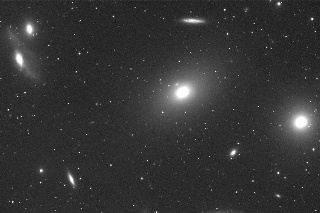
Above: A portion of the Virgo Cluster of Galaxies, with the elliptical galaxy M86 at the center (M100 is not in this image). Photo courtesy of David Hanon. Click on the image to see an enlarged view.
From the standpoint of a cosmologist, the basic building block of the universe is the galaxy. We have discovered that galaxies are not randomly distributed throughout the universe, but cluster together. Galaxy clusters gather into still larger superclusters. On the grandest scale, these superclusters are arranged in cosmic features known as filaments and voids. How do we know all this? How can we turn our two-dimensional view of the sky into a three-dimensional picture?
In this lab you will determine the distance to one of the galaxies in the Virgo Galaxy Cluster. Our Milky Way belongs to a cluster of galaxies known as the Local Group, which includes the Large and Small Magellanic Clouds, and the Andromeda Galaxy. The Virgo Cluster is the next nearest galaxy cluster, and covers over 10 degrees of sky in the constellation Virgo. The Local Group and the Virgo Cluster are both members of the Local Supercluster.

Above: A portion of the Virgo Cluster of Galaxies, with the elliptical galaxy M86 at the center (M100 is not in this image). Photo courtesy of David Hanon. Click on the image to see an enlarged view.
Although there are many varieties of variable stars, Cepheid variable stars are nearly unique in that the period, or duration, of their brightness variations is directly related to their intrinsic brightness. This unique relationship makes them ideal distance indicators. If we know how bright an object appears to be, how intrinsically bright it is, and can account for any processes that dim the light of the star in its journey to Earth, we can calculate the distance to the object. Cepheids can be identified by the specific pattern of their brightness variations. Once a variable star has been identified as a Cepheid, we can determine its distance by measuring its apparent brightness and its period. Cepheids are relatively bright stars, which also makes them desirable distance indicators--brighter stars can be seen to greater distances.
Back to Before You Begin
Back to the table of contents